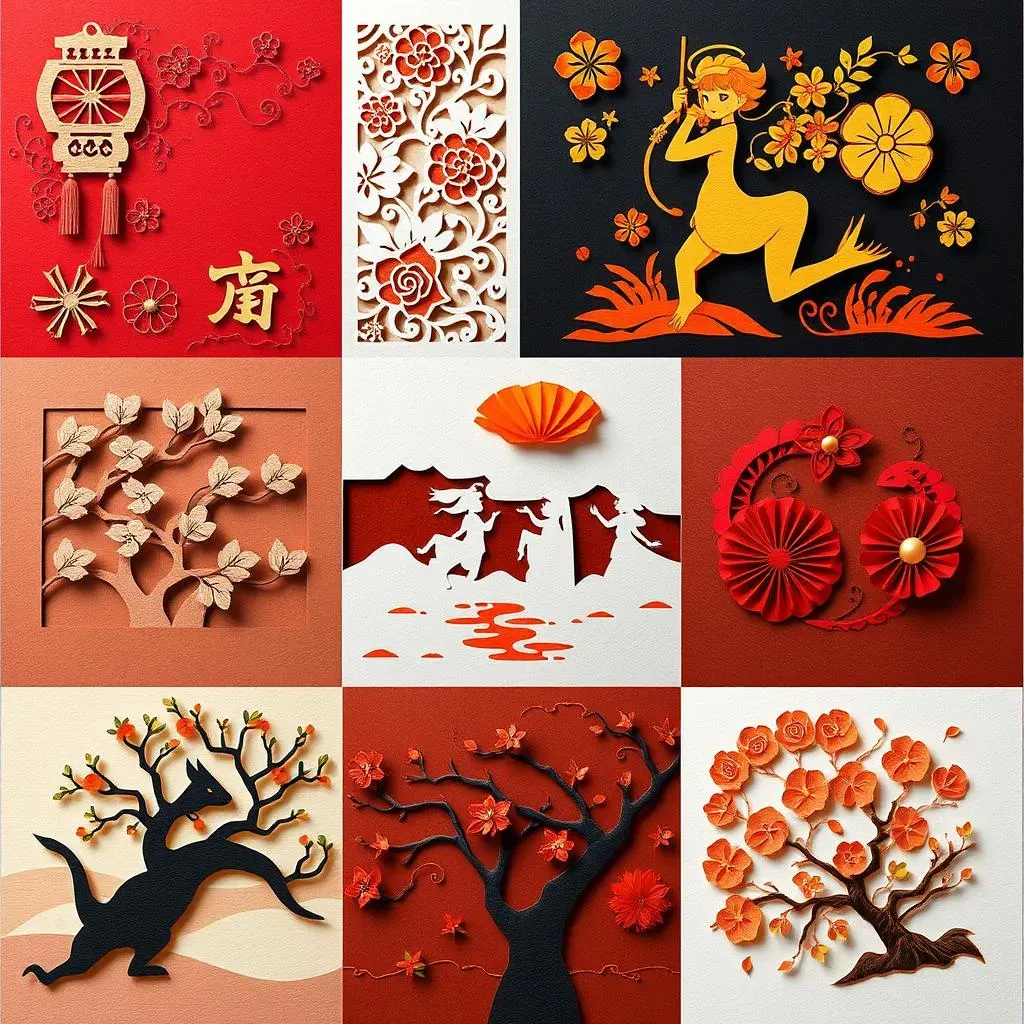Table of Contents
Ever wondered what paper cutting is all about? It's more than just snipping paper; it's a captivating art form with a rich history spanning centuries and cultures. This article will guide you through the fascinating world of paper cutting, exploring its diverse styles and techniques. We'll begin by examining what paper cutting truly entails, uncovering its origins and the cultural significance it holds in various parts of the globe. Then, we'll journey through a diverse range of paper cutting styles, from the delicate precision of Chinese Jianzhi to the playful intricacy of Japanese Kirigami. Finally, we'll equip you with practical tips and techniques, making it easy to embark on your paper cutting adventure, no matter your skill level. Whether you're a seasoned crafter or a curious beginner, prepare to be amazed by the beauty and versatility of this ancient art. So, let's dive in and uncover the secrets behind the question: what is paper cutting?
What is Paper Cutting: An Art Form Across Cultures
What is Paper Cutting: An Art Form Across Cultures
Ancient Origins and Cultural Significance
Picture this: intricate designs delicately cut from a single sheet of paper, revealing breathtaking patterns and silhouettes. That's paper cutting, a craft as old as paper itself! Its origins trace back to ancient China, where it evolved alongside papermaking, becoming a cherished tradition deeply woven into cultural celebrations and everyday life. From festive decorations to religious symbols, paper cutting became a powerful means of visual storytelling, conveying messages of prosperity, good fortune, and cultural identity.
This ancient art wasn't confined to China; it spread like wildfire, taking root in diverse cultures across the globe. Each region embraced paper cutting, infusing it with its unique aesthetic and symbolic language. Think of the vibrant Mexican *papel picado*, used to create dazzling banners for fiestas, or the intricate, often layered designs of Polish *wycinanki*, adorning homes during special occasions. These variations demonstrate paper cutting's remarkable adaptability, a testament to its enduring appeal and universal artistic potential. Want to learn more about the tools used? Check out our guide on essential paper cutting tools.
Culture | Style | Common Motifs |
|---|---|---|
China | Jianzhi | Animals, flowers, characters |
Mexico | Papel Picado | Skulls, flowers, religious symbols |
Poland | Wycinanki | Geometric patterns, birds, flowers |
Paper Cutting as a Means of Expression
But paper cutting is more than just pretty pictures; it's a powerful form of visual communication. Think of the symbolic meanings embedded in each cut, the stories whispered through delicate lines and shapes. In many cultures, paper cutting served a practical purpose, decorating homes, clothing, and religious objects. However, it also transcended the purely functional, becoming a medium for artistic expression, allowing artists to convey emotions, beliefs, and social commentary through their creations. The meticulous detail and precision involved in paper cutting often reflect the dedication and skill of the artist, adding another layer of depth to the artwork.
Over time, paper cutting evolved, adapting to new technologies and creative approaches. While traditional methods still hold immense value, contemporary artists are pushing the boundaries of the craft, exploring new materials, techniques, and themes. From intricate 3D sculptures to large-scale installations, paper cutting continues to surprise and inspire, proving its adaptability and relevance in the modern world. If you're ready to start creating your own masterpieces, discover some easy creative project ideas.
- Religious symbolism
- Cultural celebrations
- Personal expression
The Enduring Legacy of Paper Cutting
The enduring legacy of paper cutting speaks volumes about its power and appeal. It's a craft that's both ancient and modern, traditional and innovative, simple and complex. Its ability to bridge cultural divides and inspire creativity continues to captivate people worldwide. From humble beginnings as a folk art, paper cutting has evolved into a recognized art form, celebrated in museums and galleries, and practiced by artists of all skill levels. Its accessibility and versatility make it a uniquely rewarding craft, offering endless opportunities for exploration and self-expression.
The beauty of paper cutting lies in its simplicity and elegance. With just a sharp blade and a sheet of paper, artists can create intricate designs that are both visually stunning and deeply meaningful. It's a craft that invites contemplation, encouraging patience, precision, and a mindful approach to the creative process. Whether you're drawn to the precise lines of traditional styles or the playful experimentation of modern approaches, paper cutting offers a unique opportunity to connect with your creativity and explore the boundless possibilities of this ancient art form. For more inspiration, check out these amazing paper cutting decorations.
Exploring Different Styles of Paper Cutting: From Jianzhi to Kirigami
Exploring Different Styles of Paper Cutting: From Jianzhi to Kirigami
Let's dive into the incredible variety within the world of paper cutting! It's not just one style; it's a global tapestry of techniques and traditions. Take Chinese jianzhi, for example. This ancient art form, often featuring symbolic animals, flowers, and characters, is renowned for its intricate detail and bold use of red. It's deeply rooted in Chinese culture, used for celebrations and to express wishes for good fortune. Want to know more about the history of this fascinating craft? Check out our post on when Chinese paper cutting started.
Then there's Japanese kirigami, a style that often embraces more playful and less symbolic designs. Think delicate snowflakes, charming animals, or intricate geometric patterns. While jianzhi often focuses on a single sheet, kirigami sometimes incorporates folding, adding another layer of complexity and visual interest. The difference in approach showcases how a single art form can manifest in diverse and captivating ways. For those looking for a beginner-friendly approach, our beginner tutorials are a great place to start.
- Jianzhi (China): Intricate, symbolic designs, often red.
- Kirigami (Japan): Playful designs, sometimes incorporating folding.
- Papel Picado (Mexico): Vibrant, often celebratory designs using tissue paper.
Moving across the globe, we encounter Mexican papel picado, a vibrant and festive style that uses brightly colored tissue paper. Often seen as decorative banners at celebrations, papel picado uses bold, often celebratory, motifs. The use of tissue paper gives it a unique lightness and translucence, quite different from the heavier paper often used in jianzhi. This showcases the adaptability of the art form, evolving to suit the materials and cultural contexts available.
But these are just a few examples! From the delicate silhouettes of European scherenschnitte to the layered designs of Polish *wycinanki*, the world of paper cutting offers a stunning array of styles, each with its unique charm and history. Each style reflects the cultural nuances of its origin, demonstrating the universality and adaptability of this ancient art. If you're curious about the tools used in these different styles, check out our guide to essential paper cutting tools.
Style | Region | Characteristics |
|---|---|---|
Scherenschnitte | Europe | Delicate silhouettes, often black and white. |
Wycinanki | Poland | Layered designs, often featuring vibrant colors. |
Mastering Paper Cutting: Tools, Techniques, and Tips for Beginners
Essential Tools for Paper Cutting Success
First things first: let's talk tools! The right equipment makes all the difference. You'll need a sharp craft knife or scalpel – a self-healing cutting mat is a must to protect your work surface and prevent accidents. A metal ruler is helpful for straight lines, and a pair of good quality small scissors can be surprisingly useful for intricate details or fiddly bits. Don't forget tracing paper for transferring designs, and a pencil for sketching your masterpiece. Choosing the right paper is also crucial; a good quality paper, around 120-180gsm, will give you the best results. Too thin and it'll tear, too thick and it'll be hard to cut. For more detailed guidance, check out our comprehensive guide on essential tools.
Beyond the basics, consider adding some extra tools to your arsenal. Tweezers can be invaluable for picking up small cut-outs, and a magnifying glass can help with intricate detail work. A good light source is also essential, ensuring you can clearly see your design and make precise cuts. If you're feeling fancy, explore different types of paper; textured papers can add a unique dimension to your work. Remember, the right tools enhance your experience and allow you to create more stunning pieces. For more advanced techniques, you might consider exploring different types of paper cutting types.
- Sharp craft knife/scalpel
- Self-healing cutting mat
- Metal ruler
- Small scissors
- Tracing paper
- Pencil
Techniques and Tips for Paper Cutting Beginners
Now for the fun part: the actual cutting! Start with simple shapes and designs to get a feel for your tools and the paper. Don't rush; slow, steady cuts are key to achieving clean lines and preventing tears. Always cut away from yourself, keeping your fingers out of the way of the blade. If you're working from a template, lightly trace the design onto your paper to avoid smudging. For more detailed instructions, check out our step-by-step guide.
As you gain confidence, try more complex designs. Experiment with different cutting techniques; for example, using small snips for curves or precise cuts for straight lines. Don't be afraid to make mistakes; they're part of the learning process! If you make a mistake, you can often carefully cut away the error and glue in a replacement piece. Remember, the beauty of paper cutting lies in its hand-crafted nature; slight imperfections add character and uniqueness to your creations. For inspiration on what you can make, explore some easy project ideas. Let your imagination run wild and have fun!
Technique | Description |
|---|---|
Score and Fold | Create crisp folds by lightly scoring the paper before folding. |
Layered Cutting | Cut multiple layers of paper for added depth and complexity. |